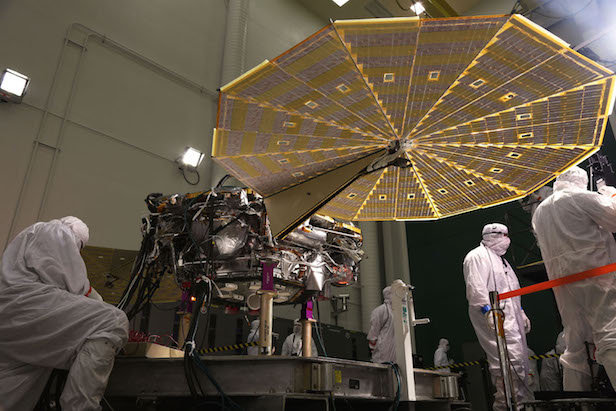InSight Lander spreads its solar wings
NASA’s InSight lander has passed a key test as it gets closer to its launch date

InSight will be launched on the 5 May 2018. Image credit: NASA/JPL-Caltech
NASA’s InSight spacecraft is another step closer to reaching the Red Planet in November 2018, as it passed a key test on 23 January 2018. The test consisted of extending its solar arrays, which are vital to powering the spacecraft for the duration of its stay.
The test for NASA’s Interior Exploration using Seismic Investigations, Geodesy and Heat Transport, also known as InSight, was conducted at Lockheed Martin Space just outside of Denver, Colorado. The team leading the mission at NASA’s Jet Propulsion Laboratory in Pasadena, California, have overseen the construction and testing at Lockheed Martian Space. Assuming all tests go smoothly, InSight will launch on the 5 May 2018.
“This is the last time we will see the spacecraft in landed configuration before it arrives at the Red Planet,” says Scott Daniels, Lockheed Martin InSight Assembly, Test and Launch Operations (ATLO) manager. “There are still many steps we have to take before launch, but this is a critical milestone before shipping to Vandenberg Air Force Base in California.”
The solar panels – that resemble a fan – are designed to optimise the weak sunlight Mars receives. As Mars is further away from the Sun, it receives roughly half as much sunlight as Earth; due to the strength of the sunlight, and the planet’s thin atmosphere, the solar panels need to be incredibly efficient. These panels will need to power InSight for at least one Martian year, which is two Earth years, to satisfy the primary mission objectives. The primary mission will be to study the deep interior of the Red Planet, and find out what’s underneath.

Engineers deploy InSight’s solar arrays whilst in its landed configuration, making sure the lander can optimise the Martian sunlight. Image credit: NASA/JPL-Caltech/Lockheed Martian
“Think of InSight as Mars’ first health checkup in more than 4.5 billion years,” says Bruce Banerdt of JPL, the mission’s principal investigator. “We’ll study its pulse by ‘listening’ for marsquakes with a seismometer. We’ll take its temperature with a heat probe, and we’ll check its reflexes with a radio experiment.”
Engineers also added something extra to the spacecraft: a microchip inscribed with more than 1.6 million names of members of the public. There was already a chip glued to the top of InSight, which was attached in 2015. This original chip contains 827,000 names, bringing the grand total up to about 2.4 million names making the journey to Mars. “It’s a fun way for the public to feel personally invested in the mission,” Banerdt says. “We’re happy to have them along for the ride.”
The chips were inscribed at JPL’s Microdevices Laboratory, which have a long track list of adding names and images to other spacecrafts. This list includes the Mars Spirit, Opportunity and Curiosity rovers. Each character on the InSight microchips is a minuscule 400 nanometres wide. This means each character is less than one per cent the width of a human hair, and five per cent the width of a red blood cell.
Keep up to date with the latest reviews in All About Space – available every month for just £4.99. Alternatively you can subscribe here for a fraction of the price!




